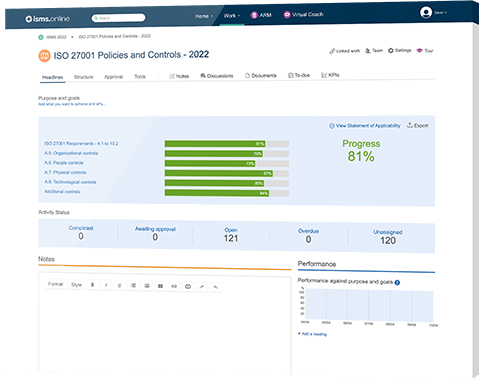
When an employee leaves his/her workstation unattended, sensitive information contained in digital and physical materials on his workspace will be exposed to a heightened risk of unauthorised access, loss of confidentiality, and damage.
For instance, if an employee uses a customer relationship management tool that processes health records and leaves his/her computer unattended during a lunch break, malicious parties may capitalise on this opportunity to steal and misuse sensitive health data.
Control 7.7 addresses how organisations can design and enforce clear desk and clear screen rules to protect and maintain the confidentiality of sensitive information on digital screens and on papers.
Control 7.7 enables organisations to eliminate and/or mitigate the risks of unauthorised access, use, damage, or loss of sensitive information on screens and on papers located in employee workstations when employees are not present.
Control 7.7 is a preventive type of control that requires organisations to maintain the confidentiality of information assets by describing and enforcing clear desk and clear screen rules.
| Control Type | Information Security Properties | Cybersecurity Concepts | Operational Capabilities | Security Domains |
|---|---|---|---|---|
| #Preventive | #Confidentiality | #Protect | #Physical Security | #Protection |
Considering that Control 7.7 requires organisations to adopt and implement an organisation-wide clear desk and clear screen policy, information security officers should be responsible for production, maintenance and enforcement of clear desk and clear screen rules that apply across the entire organisation.
Control 7.7 highlights that organisations should create and enforce a topic-specific policy that sets out clear desk and clear screen rules.
Furthermore, Control 7.7 lists seven specific requirements that organisations should take into account when establishing and enforcing clear desk and clear screen rules:
Control 7.7 cautions organisations against risks arising out of vacated facilities. When an organisation vacates a facility, physical and digital materials previously stored in that facility should be securely removed so that sensitive information is not left insecure.
Therefore, control 7.7 requires organisations to establish procedures for the vacation of facilities so that all sensitive information assets housed in that facility are securely disposed of. These procedures may include carrying out a final sweep so that no sensitive information is left unprotected.

We’ll give you an 81% headstart
from the moment you log in
Book your demo
27002:2022/7.7 replaces 27002:2013/(11.2.9)
There are two significant differences between the 2022 and the 2013 versions.
In contrast to the 2022 version, the 2013 version explicitly stated that organisations should consider organisation-wide information classification levels, legal & contractual requirements, and the types of risks facing the organisation when establishing a clear desk and clear screen policy.
The ISO 27002:2022 version, however, does not refer to these elements.
In contrast to the 2013 version, the 2022 version sets out the following requirements that organisations should consider when establishing clear desk and clear screen rules.
ISO 27002 implementation is simpler with our step-by-step checklist that guides you through the whole process. Your complete compliance solution for ISO/IEC 27002:2022.
Get in touch today to book a demo.
| ISO/IEC 27002:2022 Control Identifier | ISO/IEC 27002:2013 Control Identifier | Control Name |
|---|---|---|
| 5.7 | New | Threat intelligence |
| 5.23 | New | Information security for use of cloud services |
| 5.30 | New | ICT readiness for business continuity |
| 7.4 | New | Physical security monitoring |
| 8.9 | New | Configuration management |
| 8.10 | New | Information deletion |
| 8.11 | New | Data masking |
| 8.12 | New | Data leakage prevention |
| 8.16 | New | Monitoring activities |
| 8.23 | New | Web filtering |
| 8.28 | New | Secure coding |
| ISO/IEC 27002:2022 Control Identifier | ISO/IEC 27002:2013 Control Identifier | Control Name |
|---|---|---|
| 6.1 | 07.1.1 | Screening |
| 6.2 | 07.1.2 | Terms and conditions of employment |
| 6.3 | 07.2.2 | Information security awareness, education and training |
| 6.4 | 07.2.3 | Disciplinary process |
| 6.5 | 07.3.1 | Responsibilities after termination or change of employment |
| 6.6 | 13.2.4 | Confidentiality or non-disclosure agreements |
| 6.7 | 06.2.2 | Remote working |
| 6.8 | 16.1.2, 16.1.3 | Information security event reporting |
| ISO/IEC 27002:2022 Control Identifier | ISO/IEC 27002:2013 Control Identifier | Control Name |
|---|---|---|
| 7.1 | 11.1.1 | Physical security perimeters |
| 7.2 | 11.1.2, 11.1.6 | Physical entry |
| 7.3 | 11.1.3 | Securing offices, rooms and facilities |
| 7.4 | New | Physical security monitoring |
| 7.5 | 11.1.4 | Protecting against physical and environmental threats |
| 7.6 | 11.1.5 | Working in secure areas |
| 7.7 | 11.2.9 | Clear desk and clear screen |
| 7.8 | 11.2.1 | Equipment siting and protection |
| 7.9 | 11.2.6 | Security of assets off-premises |
| 7.10 | 08.3.1, 08.3.2, 08.3.3, 11.2.5 | Storage media |
| 7.11 | 11.2.2 | Supporting utilities |
| 7.12 | 11.2.3 | Cabling security |
| 7.13 | 11.2.4 | Equipment maintenance |
| 7.14 | 11.2.7 | Secure disposal or re-use of equipment |